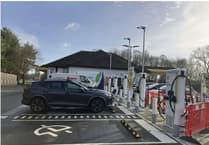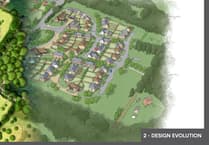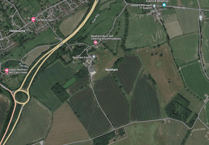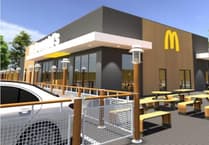Since my last meeting at the Farnham Board several people have asked me how the Farnham Infrastructure Programme came about. As I’m not a historian any account is of course only an individual perspective but my view goes something like this.
Since the bypass dual carriageway was built some 50 years ago and the one-way system introduced, Farnham has had endless and ongoing reports into what needs to be done to deal with the increasing number of cars and trucks choking the life out of a beautiful medieval streetscape flanked with listed Georgian architecture. Traffic problems happen not just in the centre but also in Farnham North and South.
When I was elected the northern part of the town suffered from degraded footpaths where they existed at all, overgrowing hedges, junctions that didn’t work and a lack of adequate safe options for pedestrians and cyclists on many roads.
When Farnham Residents asked me if I would run for Surrey, the top-tier council with responsibility for highways, having had experience as a member of a city council in Port Adelaide, South Australia, I wrote this in my leaflet: ‘The more progressive minded people work together, the more it is possible to influence important decisions and win benefits for local communities’.
Resolving traffic congestion and improving air pollution were the first two priorities on my list. I also said ‘it’s time to do things differently; where individuals from diverse views and opinions come together to discuss things with one common goal – wanting the best for Farnham and its residents’.
Many people had tried over the years to reform the traffic and deal with the air pollution problems in the town. All of that work had identified what needed to be done many times over, but no significant progress had been made. The latest attempt had been made by Jeremy Hunt MP who had been trying to advance a programme for pedestrianisation and had faced various obstacles and difficulties.
At the election count when Andy MacLeod and I were elected as the first Farnham Residents to Surrey County Council, Jeremy approached Andy and asked whether he and I might be prepared to work with him and the Tory county councillor for Farnham South, Wyatt Ramsdale, to try to get things moving.
The traditional model of political party politics involves competing tribes manoeuvring for the high moral ground and often sees progress limited unless a particular colour – blue, red, yellow or green – can see advantage and be seen to get the credit.
I am not going to pretend that political parties do not play a role at the national level and I am not going to pretend there are not important ideological differences and differences of operation between the various political groups. But my overwhelming experience, after spending time on two councils on two continents, is party politics at the local level, especially where party lines and party whips are involved, is not productive.
In an election it is understandable why people compete to get their view of the world supported. But once the election is over it is my firm view that co-operation is more important than competition to ensure residents get the things they need. To do so, fairly significant differences of view have to be put to one side to attempt to build a consensus for a way forward.
Andy and I agreed to work with Jeremy and Wyatt. In doing so we faced views that we had fallen for some ‘cunning Tory plan’ and that we were allowing ourselves to be ‘used’. My view was that the Tories didn’t have a plan for Farnham, cunning or otherwise, but they were prepared to talk and if honest, open dialogue was being ‘used’, then I was happy to do that.
What happened first was simply a series of conversations. We argued to involve as many stakeholders as possible in discussing what needed to be done. There were many meetings and many people involved, but a particular view emerged quite quickly. In time it came to be known as the ‘Duffy Plan’ round a series of proposals suggested by a local architect, Jim Duffy, that were phased and seemed to make common sense.
The Farnham Society is an important, significant, community organisation, of over 100 years’ experience that we all felt was central to any proposal to reform Farnham’s traffic and deal with the air pollution. Overwhelmingly the evidence showed the one was mostly caused by the other.
We felt we had to begin to develop community buy in to any step forward. My view in particular was that previous proposals had floundered on the rocks of competing community expectations and it was important to try to develop a majority for any move forward. In the first instance the major community organisations needed to be convinced and as The Farnham Society was one of the most significant it should be first cab off the rank. A presentation of the ‘Duffy Plan’ was made to a Farnham Society AGM and received broad support. We felt this was very important and gave us the ability to advance.
As the highways authority Surrey County Council had also to be convinced that something significant needed to be done. Experience with Surrey in our early days on the council showed that ‘no’ was the most common response when requesting traffic fixes. There were good reasons for this.
Highways budgets had been severely cut during many years of austerity. We could argue whether those cutbacks had been required or not, but that was one of the ways we tried to avoid a political approach. The cutbacks had happened, they were a reality, we had to deal with them and the consequences from them. With that reality something greater than the usual highways framework had to be utilised and we started calling for a project manager to develop the ‘Duffy Plan’ and implement it.
That was not an easy conversation and something of a false start emerged in the lead up to the Waverley elections in 2019. Yes, it had taken two years to get this far, two years of talking and painstaking detailed work. Elections always present the greatest threat to co-operation, as people move into the competition mode to win seats. Efforts to have Surrey and Waverley partly fund a project manager got somewhat distracted.
However, around that time there was also a change in Surrey within the ruling Conservative leadership. Colin Kemp – who had been a great supporter of what we were trying to do in Farnham, and had accepted invitations to visit a number of times – became deputy leader, a new leader, Tim Oliver, emerged who also took a keen interest and a new CEO, Joanna Killian, also visited the town and was open to what we were saying. The new leader at Waverley, John Ward of the rainbow Farnham Residents/Liberal Democrat/Labour/Green and Independent administration, was very supportive, as was the new leader of the town council, John Neale. All council leaders in time agreed to a partnership between the councils to take things forward.
Jeremy and Wyatt used their lobbying power on the new Tory administration at Surrey as those of us in Farnham Residents made sure the pressure stayed on from the opposition benches. I particularly majored on the HGVs on the Upper Hale Road and the need to ban them, something I was told would never happen.
I adopted a technique I had learned in Australia of ensuring that one subject was linked to any other issue I would raise or talk to people about. If people in Surrey heard nothing else I said during my term, HGVs on the Upper Hale Road was crystal clear as an issue throughout the county. The issue was raised in the full council, and in the committees including the Waverley Local Committee where the Tory chair Victoria Young was sympathetic. It got to the point where people would say ‘if you get this resolved Stephen, you’ll have nothing left to talk about’.
The traffic order to ban the trucks was issued on March 16, 2021. We wait to see what comes out of the consultation period.
The Farnham Herald was very supportive as the ideas started to move forward. When Jeremy convened an air pollution summit the Herald were behind it all guns blazing and followed up to ask when the talking would be turned into action because action was what we needed. Broader conversations with other community groups, residents’ associations, between the three levels of councils – town, borough and county (which many people do not understand or care about) – and many individuals in the town all contributed to an atmosphere that something should be done.
Support came, not without disagreement, not without sticky moments, not without some things heading off on temporary tangents. But at the centre of it Andy, Wyatt and I presented a common line to Surrey and we even got through the 2019 General Election when Jeremy as a Conservative and Paul Follows, the deputy leader of Waverley, as a Liberal Democrat, went head to head for the Westminster seat but both still supported the general direction of travel on traffic.
As the pandemic hit things started to intensify. What had been the ‘Duffy Plan’ had started to diversify into a broader conversation about what needed to be done, especially as John Neale and Mark Westcott had advanced a conversation about master planning from 2018 onwards.
This led to many other views, opinions and indeed other ‘plans’ to be drawn in. Surrey approached Waverley borough and Farnham town and suggested a partnership between the councils establishing a Farnham Board chaired by Surrey leader Tim Oliver. John Ward and John Neale were supportive. There was some argument about who should be on the board but that was resolved.
The board was established, the Farnham Infrastructure Programme was launched, project managers Chris Tunstall and Paula Gough and Atkins as consultants were appointed and the process of developing the Optimised Infrastructure Plan (OIP) began.
Through the Local Liaison Forums – chaired by Andy and John Neale, the town council leader, with Wyatt as deputy chair – hundreds of community members and groups gave their opinion on options. Every view from ‘roads are for cars and trucks, leave them alone’ to ‘cyclists and pedestrians need more attention’ was canvassed and heard. Temporary Covid measures, quite crude to start with but gradually improved, were introduced to a mixture of praise and criticism, showing that no change is straightforward.
All of the information gathered during the OIP consultation period is currently being assessed and an initial £139million has been nominated in Surrey budgets. I doubt anything definitive will be concluded until the Surrey May 6 elections have been completed.
The next stage will be the hardest once the preferred plan is announced. How that is received will depend on many things including whether the needs of Farnham North and Farnham South have been properly addressed as much as the centre of the town.
A general opinion that there should be a re-balancing between cars, cyclists and pedestrians is broadly accepted, but that will need to be translated into a sensible action plan that the majority who believe change is needed feel comfortable with.
As a member of the board, I have no idea what the traffic specialists will propose but I do know the next stage will progress without me being at the centre of it after four years’ hard work. I undertook to run for a term on Surrey County Council and then review the situation.
Thirty-five years as a trade union official, including work as a member of Equity’s senior management team and the TUC General Council, meant my promise to be ‘using his skills to get things done, against the odds, for local communities’ meant, especially if the ‘quick wins’ result in truck bans on the Upper Hale Road, Folly Hill/Castle Hill/Castle Street and some 20mph zones, on top of the Farnham Board, the FIP and the £139m in the budget, that I was able to do my bit.
The pandemic that has changed everything means a return to Australia I was not expecting will happen sooner rather than later. However, in many ways the next phase requires specialists not generalist rabble rousers, so my role in the project is largely done.
I have always organised in the community I’ve been living in, as well as in trade unions, and each time I’ve been able to contribute to making a difference. But I’ve never done it on my own.
In this case a bunch of Farnham Residents, Conservatives, Liberal Democrats – but also Labour, Greens and Independents – put their differences to one side to work with the community, the Herald, The Farnham Society and so many others to make something develop that hadn’t been achieved in some 50 years. I like to think I played my role in making that happen.
Jeremy Hunt and Wyatt Ramsdale I want to particularly mention. I doubt Andy MacLeod and I will ever be cheering on election night at the same time that they are. But their willingness to work together on traffic and air pollution issues and to get something moving is a credit to both of them.
There were as many risks on their side as there were for us but they stepped up to the challenge!
After such a great start surely something wonderful is not impossible.
By Stephen Spence
Farnham Residents county councillor for Farnham North, standing down at the May 6 election




